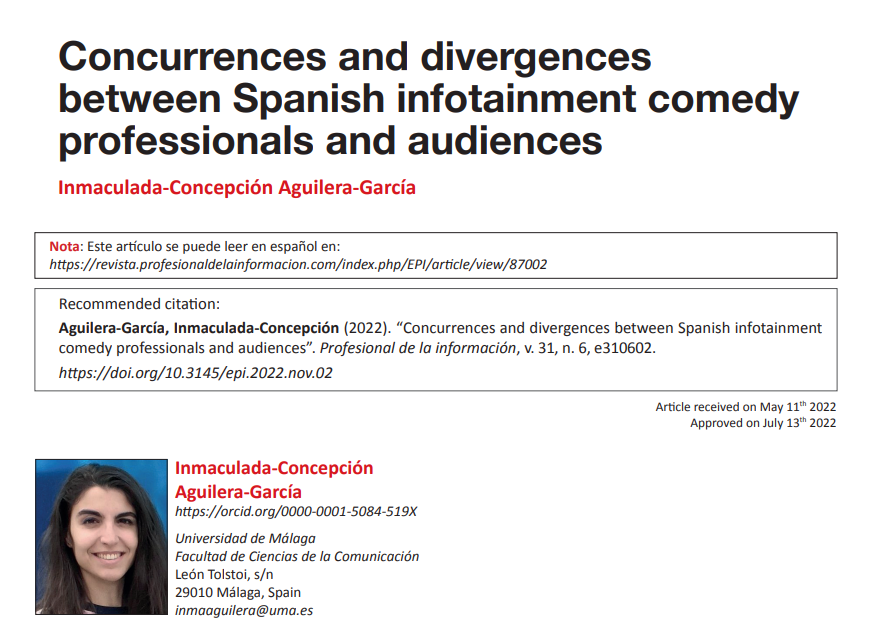
Concurrences and divergences between Spanish infotainment comedy professionals and audiences
On Sale
€15.00
€15.00
Abstract: Infotainment comedy is the branch of infotainment that mixes current affairs content with comedy. "Infotainment" is a relatively new term, first cited by Krüger (1988); as a television trend, academics agree that it must have existed much earlier, with English-language examples such as Saturday Night Live (NBC, 1975) or That was the week that was (BBC, 1962). In Spain, the roots of infotainment lie in Caiga quien caiga (Telecinco, 1996), a precursor to satirical pseudojournalism (García-Avilés, 1999). Nowadays, there are programs that present current affairs with comedy, as in the case of El intermedio (La Sexta, 2006) or Todo es mentira (Cuatro, 2019). Owing to the continuous evolution of formats and their complex definition and classification by academics and professionals, it is worth considering whether audiences also interpret the different programs in different ways depending on their elements, given that they depend on an "intuitive understanding" (Reinemann et al., 2011; Otto et al., 2017) that stems from the habit of repeated consumption. This article presents the results of a reception study contrasting Spanish infotainment comedy professionals and their audiences to assess whether their impressions of these shows are similar or if, on the contrary, their hybrid nature is so changeable that they have come to interpret them in a very different way. The methodology involved ten discussion groups with a total of 87 viewers and 13 interviews with professionals from four programs: El intermedio, Todo es mentira, Ese programa del que usted me habla (La 2, 2019), and La resistencia (Movistar+, 2018). According to the statements collected, the results revealed that audiences and content creators show more points of divergence than concurrences, which means that the messages are interpreted differently from how they were intended.
Resumen: El infohumor es la rama del infoentretenimiento que mezcla contenidos de actualidad con comedia. Como término, el infotainment es relativamente reciente, citado por primera vez por Krüger (1988); como tendencia televisiva, los académicos coinciden que debe existir de mucho antes, con ejemplos anglosajones como Saturday Night Live (NBC, 1975) o That was the week that was (BBC, 1962). En España, los antecedentes del infotainment se marcan con Caiga quien caiga (Telecinco, 1996), precursor del pseudoperiodismo satírico (García-Avilés, 1999). En la actualidad, encontramos programas que presentan contenidos de actualidad con comedia, como es el caso de El intermedio (La Sexta, 2006) o Todo es mentira (Cuatro, 2019). Debido a la continua evolución de formatos y a su compleja definición y clasificación por académicos y profesionales, cabe plantearse si las audiencias también interpreten los distintos programas de diversas formas en función de sus elementos, toda vez que se depende de un "entendimiento intuitivo" (Reinemann et al., 2011; Otto; Glogger; Boukes, 2017) que surge por el hábito de consumirlos reiteradamente. Este trabajo presenta los resultados de un estudio de recepción correspondientes a contraponer a audiencias y a profesionales de infohumor español, para valorar si sus impresiones sobre estos espacios son similares o si, por el contrario, la naturaleza híbrida de los mismos es tan cambiante que lleva a interpretarlos de muy distinta forma. Como metodología, se realizaron diez grupos de discusión a 87 espectadores totales y 13 entrevistas a profesionales de cuatro programas: El intermedio, Todo es mentira, Ese programa del que usted me habla (La 2, 2019) y La resistencia (Movistar+, 2018). En función de los testimonios recogidos, los resultados revelaron que audiencias y creadores de contenido demuestran tener más puntos de diferenciación que coincidencias, lo que supone que los mensajes se interpretan de manera distinta a cómo se idearon.
Resumen: El infohumor es la rama del infoentretenimiento que mezcla contenidos de actualidad con comedia. Como término, el infotainment es relativamente reciente, citado por primera vez por Krüger (1988); como tendencia televisiva, los académicos coinciden que debe existir de mucho antes, con ejemplos anglosajones como Saturday Night Live (NBC, 1975) o That was the week that was (BBC, 1962). En España, los antecedentes del infotainment se marcan con Caiga quien caiga (Telecinco, 1996), precursor del pseudoperiodismo satírico (García-Avilés, 1999). En la actualidad, encontramos programas que presentan contenidos de actualidad con comedia, como es el caso de El intermedio (La Sexta, 2006) o Todo es mentira (Cuatro, 2019). Debido a la continua evolución de formatos y a su compleja definición y clasificación por académicos y profesionales, cabe plantearse si las audiencias también interpreten los distintos programas de diversas formas en función de sus elementos, toda vez que se depende de un "entendimiento intuitivo" (Reinemann et al., 2011; Otto; Glogger; Boukes, 2017) que surge por el hábito de consumirlos reiteradamente. Este trabajo presenta los resultados de un estudio de recepción correspondientes a contraponer a audiencias y a profesionales de infohumor español, para valorar si sus impresiones sobre estos espacios son similares o si, por el contrario, la naturaleza híbrida de los mismos es tan cambiante que lleva a interpretarlos de muy distinta forma. Como metodología, se realizaron diez grupos de discusión a 87 espectadores totales y 13 entrevistas a profesionales de cuatro programas: El intermedio, Todo es mentira, Ese programa del que usted me habla (La 2, 2019) y La resistencia (Movistar+, 2018). En función de los testimonios recogidos, los resultados revelaron que audiencias y creadores de contenido demuestran tener más puntos de diferenciación que coincidencias, lo que supone que los mensajes se interpretan de manera distinta a cómo se idearon.
